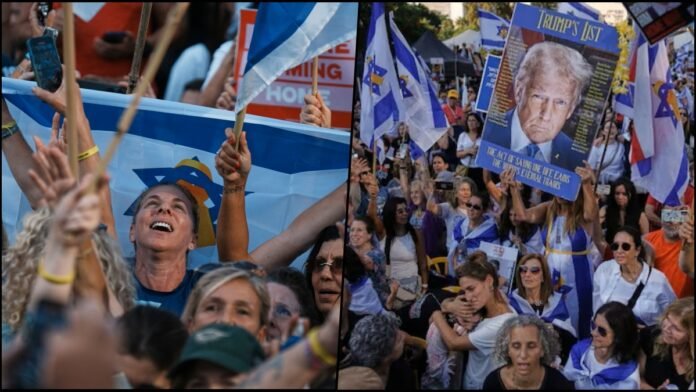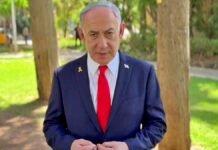
Key Points
- All 20 living Israeli hostages held by Hamas for nearly two years released on Monday, October 13, 2025, ending their 738-day captivity
- First batch of 7 hostages handed over to Red Cross in morning, followed by remaining 13 at around 7:00 AM GMT
- Hamas also returning remains of 28 deceased hostages as part of ceasefire agreement
- Israel releasing approximately 2,000 Palestinian prisoners in exchange, including 250 serving life sentences
- US President Donald Trump arrived in Israel to witness releases and address Knesset before heading to Sharm el-Sheikh summit
- Tens of thousands celebrated at Hostages Square in Tel Aviv, waving Israeli flags and watching live broadcasts
- Released hostages include twin brothers Ziv and Gali Berman, Matan Zangauker, and 17 others, mostly men in their 20s and 30s
Tel Aviv: After an agonizing 738-day wait that tested the nation’s resolve, all 20 living Israeli hostages held captive by Hamas in Gaza were released on Monday, October 13, 2025, marking a pivotal moment in the two-year conflict that began with the devastating October 7, 2023, attack. The emotional homecoming, facilitated through a US-brokered ceasefire deal, sparked jubilant celebrations across Israel as families were finally reunited with their loved ones who had endured nearly two years of captivity in the war-torn Gaza Strip.
Phased Release and Emotional Reunions
Hamas executed the hostage release in two distinct phases on Monday morning, beginning with the transfer of seven captives to the International Committee of the Red Cross (ICRC) in northern Gaza. The initial group, handed over early Monday morning, included twin brothers Ziv and Gali Berman, along with Matan Angrest, Alon Hale, and Omri Miran. The ICRC then transported these hostages to Israeli Defense Forces (IDF) personnel waiting at a designated meeting point in the Gaza Strip.
The remaining 13 hostages were subsequently released around 7:00 AM GMT (10:00 AM local time) in central Gaza and transferred to Red Cross custody. The Prime Minister’s Office identified them as David and Ariel Kunio, Avinan Or, Elkana Buhbot, Rom Breslavsky, David Avitar, Eitan Horn, Maxim Harkin, Nimrod Cohen, Segev Kalfon, Matan Zangauker, Yosef-Chaim Ohana, and Bar Kuperstein. All released hostages are men, primarily in their 20s and 30s, who were captured during the October 7, 2023, Hamas attack that killed over 1,200 Israelis and triggered the Gaza War.
Israeli television broadcast deeply moving scenes, including a video call between Einav Zangauker and her 25-year-old son Matan shortly after his liberation. “There’s no war, it’s finished. You are returning home,” she told him through tears, capturing the profound relief felt by families across the nation. The family of Omri Miran also released an emotional statement following his handover to Israeli authorities.
Medical Care and Rehabilitation Process
Following their release, the hostages were transported via military helicopters from the Re’im military base located just outside the Gaza Strip to medical facilities in the Tel Aviv area. At Re’im, they underwent initial medical assessments, were provided with showers and fresh clothing, and had brief reunions with family members before being taken to hospitals for comprehensive medical evaluations.
The Israeli government has committed to providing extensive support throughout the absorption and rehabilitation process. “The Israeli government, the security establishment, the Coordinator of the National Repatriation Service and the Directorate of Abductees, Missing Persons and Returnees in the Prime Minister’s Office will accompany them and their families throughout the entire absorption and rehabilitation process,” the Prime Minister’s office stated. Full details about the hostages’ health conditions during their captivity were not immediately available, though all 20 are confirmed to be living.
Nationwide Celebrations and Public Response
The hostage releases triggered unprecedented celebrations across Israel, with the epicenter of jubilation at Hostages Square in Tel Aviv, which has served as a vigil site throughout the two-year conflict. Tens of thousands of Israelis gathered at the plaza and various locations nationwide, waving blue-and-white Israeli flags and watching live broadcasts of the releases on large screens. The crowd erupted in cheers as each hostage was confirmed to be in Israeli custody.
Major Israeli television networks ran special overnight programming leading up to the releases, with crowds forming around large screens at Hostages Square before dawn. People danced, sang, and embraced as their fellow citizens returned home after nearly two years of captivity. The emotional scenes reflected the collective trauma experienced by Israeli society, where the hostages’ plight had become a defining national issue, with many Israelis wearing yellow pins and ribbons in solidarity throughout the ordeal.
Trump’s Historic Visit and Political Positioning
US President Donald Trump arrived in Israel on Monday to personally witness this historic moment and claim credit for the ceasefire deal that made the releases possible. Prime Minister Benjamin Netanyahu personally welcomed Trump at Ben Gurion Airport, underscoring the significance of the American president’s role in brokering the agreement. Israeli President Isaac Herzog stated on Sunday that Trump would be welcomed by “masses of Israelis with gratitude and friendship,” with many attributing the ceasefire agreement directly to the American president’s intervention.
Speaking to reporters aboard Air Force One en route to Israel, Trump declared confidently: “The war is over. Okay? You understand that?”. He expressed optimism about the ceasefire holding and described his visit as “very special”. Trump’s four-hour stay in Israel included meetings with families of hostages captured during the October 7, 2023, attack and an address to the Knesset, Israel’s parliament, where he highlighted his pivotal role in negotiating the ceasefire and hostage release deal.
The timing of Trump’s visit coincides with the Jewish holiday of Simchat Torah, marking the second anniversary of the devastating Hamas attack. After his Israel stop, Trump was scheduled to travel to Egypt’s Sharm el-Sheikh resort, where he and Egyptian President Abdel Fattah al-Sisi would co-host a summit with over 20 world leaders to advance his comprehensive plan for ending the Gaza conflict and promoting regional peace.
Netanyahu’s Political Calculations
The hostage release carries enormous political significance for Prime Minister Netanyahu, who has faced relentless pressure from hostage families throughout the conflict. Thousands participated in weekly protests alongside families, accusing Netanyahu of delaying action for political gain and prioritizing military objectives over bringing their loved ones home. Critics alleged that Netanyahu deliberately hindered earlier ceasefire proposals to maintain his coalition government and avoid political fallout.
Netanyahu has consistently blamed Hamas for obstinacy in negotiations while defending his approach as necessary to ensure Israeli security. Now, with the hostages returning, Netanyahu aims to ensure the ceasefire remains on Israel’s terms while positioning himself as the leader who ultimately secured their freedom. The successful release provides Netanyahu with significant political capital, though questions persist about why a deal took nearly two years to achieve when earlier proposals contained similar frameworks.
Palestinian Prisoner Exchange
As part of the ceasefire agreement, Israel began releasing approximately 2,000 Palestinian prisoners and detainees in exchange for the 20 living Israeli hostages. The exchange includes 250 Palestinian prisoners serving life sentences in Israeli prisons, along with over 1,700 Palestinians from Gaza who were detained without charges throughout the conflict, including nearly two dozen children.
According to Reuters, all 1,966 Palestinian prisoners scheduled for release on Monday boarded buses at Israeli detention facilities. Of these, 1,716 individuals from Gaza were to be transferred to Nasser crossing in Gaza, while approximately 250 Palestinians serving life sentences would be released to the West Bank, Jerusalem, or abroad. The Palestinian Prisoners’ Media Office confirmed that released prisoners were en route to Gaza by Monday afternoon.
This prisoner exchange represents one of the largest such swaps in the Israeli-Palestinian conflict’s history, reflecting the high stakes involved in securing the hostages’ freedom. The release of prisoners serving life sentences has generated controversy within Israel, with some citizens questioning whether the price was too high, though most Israelis have rallied behind bringing the hostages home.
Remains of Deceased Hostages
In addition to the 20 living hostages, Hamas is obligated under the ceasefire agreement to return the remains of 28 deceased hostages. However, the Palestinian organization has claimed it has been unable to locate all of the bodies, raising concerns about whether all remains can be recovered and returned to families for proper burial. The return of remains represents a crucial element of closure for families whose loved ones did not survive captivity.
Israeli authorities have not provided specific timelines for when all remains will be returned, and the inability to locate some bodies has created additional anguish for affected families. The fate of these deceased hostages has been a sensitive issue throughout the conflict, with families demanding accountability and answers about the circumstances of their deaths.
Humanitarian Situation in Gaza
As hostages returned to Israel, hundreds of trucks carrying humanitarian aid began entering Gaza through various crossings, addressing the catastrophic humanitarian crisis that has left the territory devastated by famine and displacement. The ceasefire agreement includes provisions for substantial increases in humanitarian assistance to Gaza’s population, which has suffered immensely during the two-year conflict.
Palestinians displaced to southern Gaza during Israel’s military operations have begun returning to northern territories, where they are confronting widespread devastation, with large areas of Gaza City left in ruins. The scale of destruction has raised urgent questions about reconstruction efforts and Gaza’s future governance. Trump’s peace plan envisions the creation of a new governing body for Gaza, coordinated by a US-led multinational force, as Israel gradually withdraws from the territory.
Peace Summit and Future Prospects
Following his Israel visit, President Trump was scheduled to travel to Sharm el-Sheikh, Egypt, for a major peace summit aimed at solidifying the ceasefire and charting a path forward for Gaza and the broader Middle East region. The summit, co-hosted by Trump and Egyptian President al-Sisi, brings together over 20 world leaders to discuss the implementation of Trump’s comprehensive peace plan.
Trump emphasized that he has “guarantees” from key regional players about the deal’s initial phase and expressed optimism about future steps, despite significant challenges remaining. These challenges include Hamas’s refusal to disarm, Israel’s gradual withdrawal from Gaza, and the establishment of new governance structures acceptable to all parties. The developments signal a major milestone in the fragile peace process, offering hope for stability in the region while underscoring the considerable obstacles that remain in implementing a lasting resolution.
The success or failure of this ceasefire and the subsequent phases of Trump’s peace plan will likely define the trajectory of the Israeli-Palestinian conflict for years to come, with the international community closely watching whether this moment of hope can be transformed into lasting peace.



















































